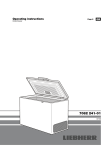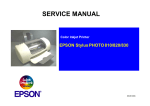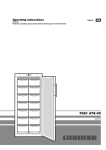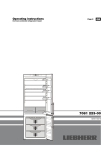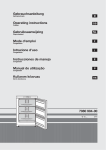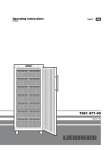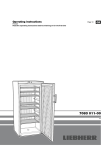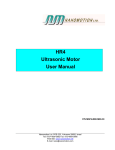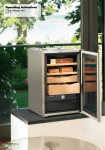Download Liebherr Chest Freezer 7081 157-00 User's Manual
Transcript
Operating instructions Chest freezer Page 6 GB 7081 157-00 GT 210 Disposal notes • Keep packaging materials away from children - polythene sheets and bags can cause suffocation! • Please return the packaging to an official collection point. Your old appliance: This contains some reusable materials and should be disposed of properly - not simply with unsorted household refuse. • Discarded appliances should be disabled: Remove the plug, cut through the connection cable and render the catch unusable so that children cannot become trapped inside. • Ensure that the refrigerant circuit is not damaged when the appliance that is no longer needed is taken away for disposal. • Details of the refrigerant can be found on the type plate. • Appliances which are no longer needed must be disposed of in a professional and appropriate way, in accordance with the current local regulations and laws. Range of appliance use The appliance is suited only for cooling food. In the case of commercial food cooling, the pertinent statutory regulations have to be observed. The appliance is not suited for storing and cooling pharmaceuticals, blood plasma, laboratory preparations or similar substances and products subject to the Medical Devices Directive 2007/47/EC. Any misuse of the appliance may result in damage to or spoilage of the stored goods. Furthermore, the appliance is unsuited for use in areas exposed to an explosion hazard. Description of appliance and equipment Freezing chart Interior light Lock Type plate Operating and control elements Compressor compartment ventilation grille Defrost drain Before starting up the appliance, plug the defrost drain opening in the floor of the appliance with the plug provided. This is important to ensure that the appliance works properly. 6 Safety instructions and warnings • To prevent injury or damage to the unit, the appliance should be unpacked and set up by two people. • In the event that the appliance is damaged on delivery, contact the supplier immediately before connecting to the mains. • To guarantee safe operation, ensure that the appliance is set up and connected as described in these operating instructions. • Disconnect the appliance from the mains if any fault occurs. Pull out the plug, switch off or remove the fuse. • When disconnecting the appliance, pull on the plug, not on the cable. • Any repairs and work on the appliance should only be carried out by the customer service department, as unauthorised work could prove highly dangerous for the user. The same applies to changing the mains power cable. • Do not allow naked flames or ignition sources to enter the appliance. When transporting and cleaning the appliance ensure that the refrigerant circuit is not damaged. In the event of damage, make sure that there are no ignition sources nearby and keep the room well ventilated. • Do not stand on the plinth, drawers or doors or use them to support anything else. • This appliance is not intended for use by persons (including children) with reduced physical, sensory or mental capabilities or lack of experience and knowledge unless they have been given initial supervision or instruction concerning use of the appliance by a person responsible for their safety. Children should be supervised to ensure that they do not play with the appliance. • Avoid prolonged skin contact with cold surfaces or chilled/frozen food. This could cause pain, numbness and frostbite. In the case of prolonged skin contact, protective measures should be taken, e.g. gloves should be worn. • Do not eat ice cream, particulary ice lollies or ice cubes, immediately after taking them from the freezer compartment as there is a risk of "burning" because of the very cold temperatures. • Do not consume food which has been stored for too long, as it could cause food poisoning. • The appliance is designed for cooling, freezing and storage of food, and for making ice and is intended for domestic use. If used for commercial purposes, the relevant legal regulations applicable to the trade concerned must be observed. • Do not store explosives or sprays using combustible propellants such as butane, propane, pentane etc. in the appliance. Electrical components might cause leaking gas to ignite. You may identify such sprays by the printed contents or a flame symbol. • Do not use electrical appliances inside the appliance. • If you have a lockable appliance, do not keep the key near the appliance or within reach of children. • The appliance is designed for use in enclosed areas. Do not operate the appliance outdoors or in areas where it is exposed to splash water or damp conditions. Climate rating The appliance is set to operate within specific ambient temperature limits according to its climate rating.These temperature limits should not be exceeded. The correct climate rating for your appliance is indicated on the type plate. Climate rating SN N ST T Ambient temperature +10°C to +32°C +16°C to +32°C +16°C to +38°C +16°C to +43°C Setting up • Avoid positioning the appliance in direct sunlight or near cookers, radiators and similar sources of heat. • The floor on which the appliance stands must be horizontal and level. Place the appliance far enough away from the wall so that the lid can be opened and closed unhindered. 1Do not cover the gap between the lower edge of the freezer and the floor, as the refrigeration unit has to be supplied with air for cooling. There must be a gap of at least 20 cm between the ventilation grille and the wall. This gap must be kept clear and the ventilation openings uncovered. Do not place any objects immediately next to the outer housing of the appliance. There must be a gap of at least 20 mm all round in order to ensure adequate heat discharge. To switch the appliance on: Connect the appliance to the mains - the appliance is switched on. • Standard EN 378 specifies that the room in which you install your appliance must have a volume of 1 m3 per 8 g of R 600a refrigerant used in the appliance, so as to avoid the formation of inflammable gas/air mixtures in the room where the appliance is located in the event of a leak in the refrigerant circuit. The quantity of refrigerant used in your appliance is indicated on the type plate. • Do not connect the appliance to the supply with other equipment using an extension cable - risk of overheating. Model GT 2102 GT 5102 GTS 1412 GTS 2112 GTS 2212 GTS 2612 GTS 3012 GTS 3612 GTS 4212 GTS 4912 GTS 6112 Height 852 850 890 862 917 917 917 917 917 917 917 Width 838 1698 545 837 998 872 998 1132 1288 1372 1647 Connect the appliance with a properly earthed fused plug and socket only. You are recommended to clean the appliance before switching it on for the first time (see "Cleaning"). 3 Power supply (a.c.) and voltage at the operating point must comply with the details on the type plate. The socket must be fused with a 10 A fuse or higher, it must be away from the rear of the appliance and must be easily accessible. Switching the appliance on and off 2 Dimensions (mm) Connecting to the mains GB Depth 676 730 640 730 760 760 760 760 760 809 809 Saving energy - Always ensure good ventilation. Do not cover ventilation openings or grille. - Do not place appliance in areas of direct sunlight or next to a stove, heater or similar object. - The energy consumption depends on the installation conditions, e.g. the ambient temperature. - Keep the time the appliance is open to a minimum. - Store food logically. - Ensure that all food is well packed and covered for storage. This will prevent frost from forming. - First cool warm food to room temperature before storing it. - If there is a thick layer of frost in the appliance: defrost the appliance. Accumulated dust increases the energy consumption: - Once a year, dust the refrigerating unit together with the metal grille of the heat exchanger at the back of the appliance. - The green ON lamp 1comes on. - The red alarm lamp 2comes on. The red alarm lamp goes out as soon as the freezer compartment is cold enough. To switch the appliance off: Pull out the mains plug or remove/unscrew the fuse. Setting the temperature Using a coin, turn the arrow on the temperature control to a setting between 2 und 7. Setting 2 = lowest cooling setting Setting 7 = highest cooling setting, cold For long-term storage of frozen food a temperature of at least -18 °C is recommended. If the chest is filled up to the bottom stacking marking (see "Freezing"), the temperature control can be set to the "economy" setting. The power consumption will then be kept to a minimum. Control elements The red "ALARM" lamp 2 comes on if the temperature in the freezer compartment is not cold enough. If the red alarm lamp comes on during normal operation, check: - whether there has been a lengthy interruption to the power supply, - whether the lid is properly shut, - whether fresh food has recently been inserted. If none of the above apply, consult your nearest customer service department as soon as possible, giving details of the type of appliance, index and appliance number. The yellow SUPERFROST lamp 3 lights up when the SUPERFROST facility is switched on for freezing large quantities of fresh food (see Freezing). 7 Freezing Fresh food should be frozen to the core as rapidly as possible. This is provided by the "Superfrost" facility. The maximum amount of food wich can be frozen in 24 hours is shown on the type plate (Freezing capacity ...kg/24 hours). NB: The upper stacking limit is the top level of the basket! If the chest is loaded up to a maximum of 300 mm below the top level of the basket, the appliance can be set to the "economy" setting. This setting reduces the amount of power consumed by your chest freezer even further. Equipment Interior light The interior light switches on automatically when the lid is opened and switches off again when it is closed. Bulb data: 15 W (never use a bulb rated at more than 15 W). The voltage should agree with the details on the type plate. Bulb fitting: E 14. Replacing the bulb: Pull out the mains plug or remove/unscrew the fuse. - Remove the cover panel in the direction of the arrow. - Change the bulb. - Replace the cover panel. The temperature should in any case be set so that if you place a thermometer on the top of the frozen food it reads at least -18 °C. Freezing with Superfrost • Switch on the Superfrost switch 3. The yellow Superfrost lamp comes on. • Wait 24 hours. • Place the fresh food in the freezer. After a further 24 hours the fresh food is frozen. • Switch off the Superfrost switch 3. You should not switch on the Superfrost function: - when placing frozen food in the freezer; - when freezing up to approx. 2 kg fresh food daily. Notes on freezing and storage • Pack food which you are freezing yourself in quantities appropriate to your household. To ensure that the food freezes right through, the following quantities should not be exeeded per package: fruit, vegetables: up to 1 kg, meat: up to 2,5 kg. • In order to achieve fast freezing, food should be in contact with the interior walls when it is placed in the freezer. • Pack frozen food in standard freezer bags or reuseable plastic, metal or aluminium containers. • Do not allow fresh food which is to be frozen to come into contact with food already frozen. Always keep packs dry in order to avoid them sticking together. • Always write the date and contents on the pack and do not exeed the stated storage time for the food. • Do not freeze bottles and cans which contain carbonated drinks as they might burst. • Only take out as much food as is immediately required for thawing. Use food which has been thawed in prepared meals as quickly as possible. Frozen food can be thawed in the following ways: –in a fan oven –in a microwave oven –at room temperature –in the refrigerator: the cold given off by the frozen food is used for cooling. 8 Baskets The baskets make it easier for you to sort food. The baskets at the top can be suspended in the frame of the freezer by their handles.The baskets underneath stand on the floor of the freezer or on the inward-facing handles of the very bottom basket. Press the handle downwards, lift and tilt inwards. Lock If your appliance has no lock fitted, you can fit one retrospectively (except model GTS 1412, GT 2102, GTS 2112). Freezing chart This is located on the inside of the freezer lid. The freezing chart represents the frozen food and the time it can be safely stored in months. The individual storage times and whether or not the lower or upper value is applicable depend on the food quality, its processing prior to freezing, and the individual household's quality requirements.The lower values always apply to food with a high fat content. Freezer tray (depending on options) You can use the freezer tray to gently freeze fruit (e.g. berries or slices of fruit), herbs and vegetables for serving or garnishing. Spread the food out loosely on the tray (the pieces of fruit will retain their shape and will not stick together). Temperature display (depending on options) The thermometer shows the warmest frozen food temperature. It is adjusted and designed so that only temperatures below 0°C are accurately displayed. Defrosting After the appliance has been in operation for some time, a layer of frost or ice will form on the inside walls. This increases energy consumption. You should therefore defrost the appliance regularly. • Switch the appliance off to defrost. Pull out the mains plug or remove/unscrew the fuse. • Wrap the frozen food in paper or blankets and store in a cool place. • Remove the plug from the drain opening. Remove the dividing wall or freezer tray and place underneath the appliance so that the defrosted water escapes through the drain opening into the dividing wall or the freezer tray. • Leave the lid open while defrosting. After defrosting mop up the remaining water and clean the appliance. If your appliance does not have a drain opening, wipe up the defrosted water with a sponge or a cloth. Do not use any mechanical devices or other artificial aids for defrosting other than those recommended by the manufacturer. Cleaning GB Before cleaning always switch off the appliance. Pull out the mains plug or remove/unscrew the fuse. Clean the inside, equipment parts and outer walls with lukewarm water and a little detergent. Do not use abrasive or acid cleaners or chemical solvents. Do not use steam cleaners because of the risk of injury and damage. • Ensure that no cleaning water penetrates into the electrical components or ventilation grille. • Dry all parts well with a cloth. • The ventilation grilles should be cleaned regularly with a brush or vacuum cleaner. Dust deposits increase energy consumption. Ensure that none of the wires or other components are dislodged, bent or damaged. Malfunctions You may be able to rectify the following faults by checking the possible causes yourself: • Appliance does not function, the control lamps are not lit: - Is the plug correctly fitted in the mains socket? - Is the socket fuse intact? • Loud running noise: - Is the appliance set up firmly on the floor? - Does the appliance cause nearby items of furniture or objects to vibrate? Please note that noises caused by the refrigerant circuit cannot be avoided. • The temperature is not low enough: - Is the temperature setting correct (see "Setting the temperature")? - Have excessive amounts of fresh food been placed in the appliance? Observe the temperature display for a further 24 hours. - Does the separately installed thermometer show the correct reading? - Is the ventilation system working properly? - Is the appliance set up too close to a heat source? If none of the above causes apply and you cannot rectify the fault yourself, contact the nearest customer service department stating the type of appliance 1, index 2 and appliance number 3 as indicated on the type plate. The type-plate is located on the top of the right-hand side wall of the freezer. Shutting your appliance down If your appliance is to be shut down for any length of time, switch it off and disconnect the plug or remove the fuse. Clean the appliance and leave the lid open in order to prevent unpleasant smells. The appliance complies with the relevant safety regulations and EC directives 2004/108/EC and 2006/95/EC. All types and models are subject to continuous improvement and the manufacturer therefore reserves the right to make modifications to the shape, equipment and technology. 9






